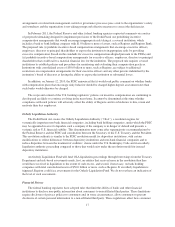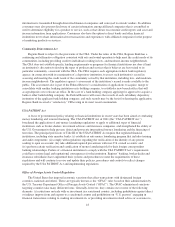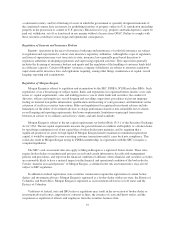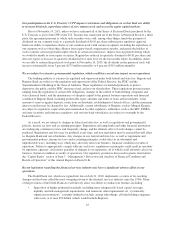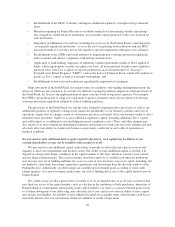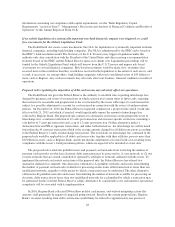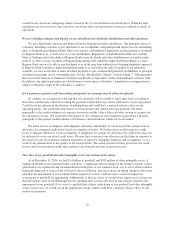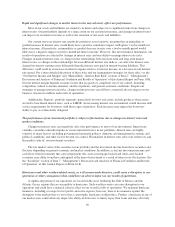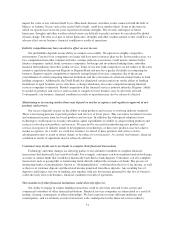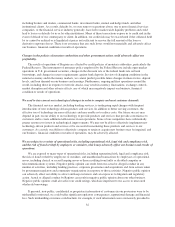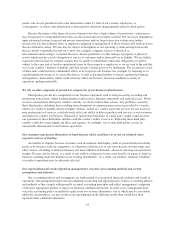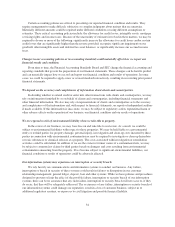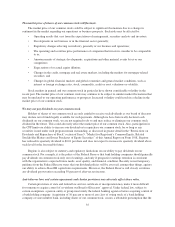Regions Bank 2010 Annual Report Download - page 40
Download and view the complete annual report
Please find page 40 of the 2010 Regions Bank annual report below. You can navigate through the pages in the report by either clicking on the pages listed below, or by using the keyword search tool below to find specific information within the annual report.• Establishment of the FSOC to identify and impose additional regulatory oversight of large financial
firms;
• Mandates requiring the Federal Reserve to establish standards for determining whether interchange
fees charged by certain financial institutions are reasonable and proportional to the costs incurred by
such institutions;
• Imposition of additional costs and fees, including fees to be set by the Federal Reserve and charged to
“systemically significant institutions” to cover the cost of regulating such institutions and any FDIC
assessment made to cover the costs of any regular or special examination of Regions or its affiliates;
• Establishment of the CFPB with broad authority to implement new consumer protection regulations
and to examine and enforce compliance with federal consumer laws;
• Application to bank holding companies of regulatory capital requirements similar to those applied to
banks, which requirements exclude, on a phase-out basis, all trust preferred securities and cumulative
preferred stock from Tier 1 capital (except for preferred stock issued under the U.S. Treasury’s
Troubled Asset Relief Program (“TARP”), such as the Series A Preferred Stock, which will continue to
qualify as Tier 1 capital as long as it remains outstanding); and
• Establishment of new rules and restrictions regarding the origination of mortgages.
Many provisions in the Dodd-Frank Act remain subject to regulatory rule-making and implementation, the
effects of which are not yet known. As a result, it is difficult to gauge the ultimate impact of certain provisions of
the Dodd-Frank Act because the implementation of many concepts is left to regulatory agencies. For example,
the CFPB is given the power to adopt new regulations to protect consumers and is given control over existing
consumer protection regulations adopted by federal banking regulators.
The provisions of the Dodd-Frank Act and any rules adopted to implement those provisions as well as any
additional legislative or regulatory changes may impact the profitability of our business activities and costs of
operations, require that we change certain of our business practices, materially affect our business model or affect
retention of key personnel, require us to raise additional regulatory capital, including additional Tier 1 capital,
and could expose us to additional costs (including increased compliance costs). These and other changes may
also require us to invest significant management attention and resources to make any necessary changes and may
adversely affect our ability to conduct our business as previously conducted or our results of operations or
financial condition.
We may need to raise additional debt or equity capital in the future; such capital may be dilutive to our
existing shareholders or may not be available when needed or at all.
We may need to raise additional capital in the future to provide us with sufficient capital resources and
liquidity to meet our commitments and business needs. Our ability to raise additional capital, if needed, will
depend on, among other things, conditions in the capital markets at that time, which are outside of our control,
and our financial performance. The recent economic slowdown and loss of confidence in financial institutions
may increase our cost of funding and limit our access to some of our customary sources of capital, including, but
not limited to, inter-bank borrowings, repurchase agreements and borrowings from the discount window of the
Federal Reserve. Additionally, our debt ratings are currently not investment grade according to some credit
ratings agencies. As a non-investment grade issuer, our cost of funding and access to the capital markets may be
further limited.
We cannot assure you that capital will be available to us on acceptable terms or at all. Any occurrence that
may limit our access to the capital markets, such as a decline in the confidence of debt purchasers, depositors of
Regions Bank or counterparties participating in the capital markets, our status as a non-investment grade issuer,
or a further downgrade of our debt rating, may adversely affect our capital costs and our ability to raise capital
and, in turn, our liquidity. An inability to raise additional capital on acceptable terms when needed could have a
materially adverse effect on our business, financial condition or results of operations.
26



